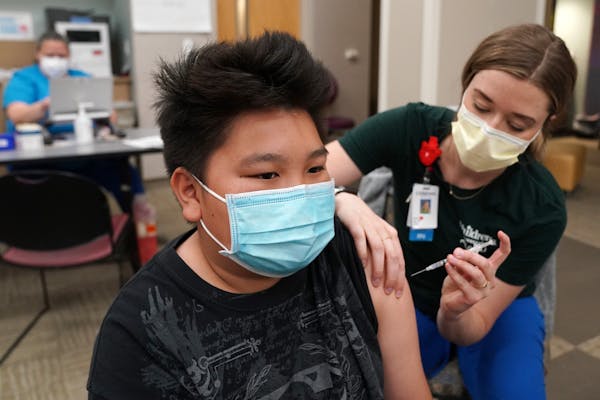Minnesota is increasing its search for more infectious strains of the coronavirus that causes COVID-19, hoping to identify any troubling variants that could reverse the sharp declines in pandemic activity over the last month.
Four of five key pandemic measures are below Minnesota's high-risk thresholds for the first time since last summer — with the positivity rate of diagnostic testing dropping to a near-record low of 3.4% on Wednesday and the daily rate of new infections receding below 10 per 100,000 people for the first time since last July.
Minnesota's hospitalization rate of COVID-19 patients also returned to a level last seen in March before the latest wave of viral transmission.
The declines present an ideal chance to increase surveillance through genomic sequencing, which can provide an early warning if a variant causes a higher rate of infection among unvaccinated people or more "breakthrough" infections among vaccinated people, said Kenny Beckman, director of the University of Minnesota Genomics Center, which has sequenced 3,000 samples from positive COVID-19 cases in Minnesota.
"What you want to know as early as possible is, has there been some change in the virus that is enabling it to escape the immune system? The only way to do that is to be proactive with these cases," Beckman said. "Surveillance is not the kind of thing you wait to do once you have a problem."
Minnesota has been a leader nationally in sequencing, which uncovers the unique signatures of viruses that can identify where they originate and whether they are more infectious or likely to cause severe illness.
The state sequenced 7,780 samples from positive cases in the four-week period ending May 8, according to the Centers for Disease Control and Prevention. Only Florida sequenced more samples in that time frame.
A new CDC contract announced Wednesday is increasing that capacity — funding analysis of 6,000 more samples by the U genomics lab over the next year for Minnesota and eight other states.
Depending on need, the extra capacity beyond the state-funded sequencing could allow for more random spot checks of COVID-19 cases to look for variants, or detailed sequencing of entire clusters.
Genomic sequencing in Minnesota has mapped out chains of viral transmission — connecting infections from the Sturgis motorcycle rally in South Dakota last summer, and confirming a variant-fueled outbreak this winter that centered on youth sports in suburban Carver County.
Key goals now are to use sequencing to track the emergence of variants, and to support research that figures out why some people suffer more severe COVID-19 illnesses than others, said Sean Wang, the Minnesota Department of Health's sequencing and bioinformatics supervisor.
"There are still a lot of unknowns about SARS-CoV-2, biologically," he said.
The state on Wednesday reported no additional COVID-19 deaths and only 128 new infections — raising its pandemic totals to 7,427 fatalities and 601,645 known infections.
State health officials said vaccination has limited virus transmission — with nearly 3 million Minnesotans 12 and older receiving at least some vaccine and more than 2.6 million completing the one- or two-dose series.
Children 12 to 15 only received access in mid-May to the Pfizer version of COVID-19 vaccine, and 27% of them already have received shots. Nearly 65% of Minnesotans 16 and older have received doses, bringing the state closer to its goal of vaccinating 70% of that population by July 1.
The vaccines appear to be maintaining their protectiveness even with the presence of more infectious variants, including the B.1.1.7 variant first identified in England that is now causing three-fourths of new infections in Minnesota, said Jan Malcolm, state health commissioner.
"People can feel very reassured by the strength of the data that the CDC has put out about the real-world experience of vaccine effectiveness," she said. "We certainly have seen it here in Minnesota with the dramatic decline in cases and hospitalizations and deaths."
Breakthrough cases
Breakthrough infections continue to be found in only 0.1% of fully vaccinated individuals, which means it has been at least 14 days since they received their final shots. The 2,765 breakthrough infections identified in Minnesota so far included 32 deaths as well as 273 hospitalizations. Almost half of the people who were hospitalized were admitted for other reasons, however, and discovered their infections through routine testing.
Most breakthrough infections submitted for genomic sequencing are traced to B.1.1.7, which isn't surprising since the variant is causing the majority of new infections in Minnesota. However, state health officials are concerned that sequencing of samples from 604 breakthrough infections has identified 52 related to the B.1.427/429 variants, first found in California; 10 related to the B.1.351 variant found in South Africa; and 15 related to the P.1 variant found in Brazil.
While those numbers are too low to draw conclusions, they suggest that "we need to learn more about the relationship between the mutations in these variants and vaccine efficacy," said Stephanie Meyer, the state Health Department's breakthrough and variant investigations coordinator.
Malcolm said it will be important to push beyond the 70% vaccination goal this summer and provide shots to as many Minnesotans as possible — and to address parts of the state where rates remain low. The first-dose vaccination rate of people 16 and older has exceeded 70% in the Twin Cities metro area but is 57% in greater Minnesota.
"It does matter to be able to get ahead of the emergence of variants," Malcolm said. "If we have pockets of the state where the virus is able to spread more easily and spin off additional variants, potentially, that's of concern to the whole population."
Jeremy Olson • 612-673-7744

Minneapolis reaches $150k settlement with eyewitness of George Floyd's murder who claims experience gave him PTSD
He grew up legally in Minnesota, but immigration law gap may one day force student to leave

911 transcript gives more detail of Sen. Mitchell's alleged burglary

